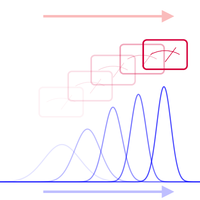Optimal Zeno Dragging for Quantum Control: A Shortcut to Zeno with Action-Based Scheduling Optimization
引用次数: 0
Abstract
The quantum Zeno effect asserts that quantum measurements inhibit simultaneous unitary dynamics when the “collapse” events are sufficiently strong and frequent. This applies in the limit of strong continuous measurement or dissipation. It is possible to implement a dissipative control that is known as “Zeno dragging” by dynamically varying the monitored observable, and hence also the eigenstates, which are attractors under Zeno dynamics. This is similar to adiabatic processes, in that the Zeno-dragging fidelity is highest when the rate of eigenstate change is slow compared to the measurement rate. We demonstrate here two theoretical methods for using such dynamics to achieve control of quantum systems. The first, which we shall refer to as “shortcut to Zeno,” is analogous to the shortcuts to adiabaticity (counterdiabatic driving) that are frequently used to accelerate unitary adiabatic evolution. In the second approach, we apply the Chantasri-Dressel-Jordan stochastic action [PRA 88, 042110 (2013)], and demonstrate that the extremal-probability readout paths derived from this are well suited to setting up a Pontryagin-style optimization of the Zeno-dragging schedule. A fundamental contribution of the latter approach is to show that an action suitable for measurement-driven control optimization can be derived quite generally from statistical arguments. Implementing these methods on the Zeno dragging of a qubit, we find that both approaches yield the same solution, namely, that the optimal control is a unitary that matches the motion of the Zeno-monitored eigenstate. We then show that such a solution can be more robust than a unitary-only operation and we comment on solvable generalizations of our qubit example embedded in larger systems. These methods open up new pathways toward systematically developing dynamic control of Zeno subspaces to realize dissipatively stabilized quantum operations.

量子控制的最佳芝诺拖动:基于行动的调度优化:通往芝诺的捷径
量子芝诺效应断言,当 "坍缩 "事件足够强烈和频繁时,量子测量会抑制同时进行的单位动力学。这适用于强连续测量或耗散的极限。通过动态改变受监控的可观测物,进而改变作为芝诺动力学吸引子的特征状态,可以实现被称为 "芝诺拖曳 "的耗散控制。这与绝热过程类似,当特征状态的变化速度慢于测量速度时,芝诺拖动的保真度最高。我们在此展示了利用这种动力学实现量子系统控制的两种理论方法。第一种方法,我们称之为 "芝诺捷径",类似于常用于加速单元绝热演化的绝热捷径(反绝热驱动)。在第二种方法中,我们应用了 Chantasri-Dressel-Jordan 随机作用[PRA 88, 042110 (2013)],并证明由此推导出的极值概率读出路径非常适合对芝诺拖曳时间表进行庞特里亚金式的优化。后一种方法的一个基本贡献是证明了适合测量驱动控制优化的行动可以很普遍地从统计论证中推导出来。在对一个量子比特的芝诺拖动实施这些方法时,我们发现这两种方法都能得到相同的解决方案,即最优控制是一个与芝诺监测特征状态的运动相匹配的单元。然后,我们证明这种解决方案比单纯的单元操作更稳健,并对嵌入更大系统中的量子比特示例的可解广义性进行了评论。这些方法为系统地开发芝诺子空间的动态控制以实现耗散稳定的量子操作开辟了新的途径。
本文章由计算机程序翻译,如有差异,请以英文原文为准。
求助全文
约1分钟内获得全文
求助全文

 求助内容:
求助内容: 应助结果提醒方式:
应助结果提醒方式:


